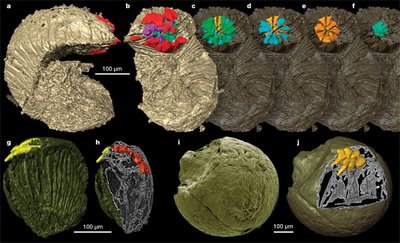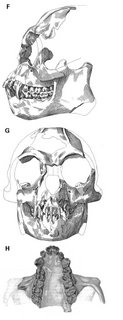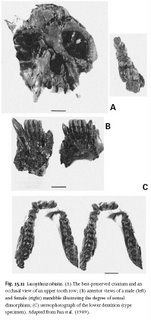Thursday, August 31, 2006
Update on Forthcoming Posts
I've been preoccupied with the start of the new semester and other distractions, but plan on a number of new posts in the immediate future. Right now I'm working on an extensive post dealing with the historical geology of China and east Asia in general. There is surprisingly little available on-line relating to this important topic, which is necessary background for understanding the natural history and evolutionary biology of China. Nevertheless, I've been able to compile a fairly comprehensive overview relating to this subject matter.
I'll also be posting on recent articles concerning the relationship of Neanderthals to modern humans based on both archeological and genetic data, and further research regarding the status of the Flores hominid.
Sunday, August 13, 2006
More on the Pre-Cambrian Fossils of China
In my previous post I introduced readers to the pre-Cambrian fossil record of China. The Doushantuo Formation has garnered most attention, but there are other notable Ediacaran sequences in South China. These were the subject of a recent conference entitled: The Cryogenian and Ediacaran of South China: Ice Ages, Animal Embryos, Acritarchs, and Algae, held from June 6-16, 2006 in Beijing. Pre-Congress excursions visited major Neoproterozoic sites throughout South China. The following excerpts from the Congress program gives a feel for these exciting discoveries:
The Neoproterozoic is emerging as one of the focuses in the study of Earth system history. Recent progress in the study of Cryogenian and Ediacaran successions of South China has significantly expanded our knowledge about Neoproterozoic Earth system history. For example, the discovery of animal embryo and macroalgal fossils in the Doushantuo Formation and unusually preserved Ediacara fossils in the Dengying Formation provides key paleontological evidence for the evolution of multicellular eukaryotes. Recently acquired high-resolution radiometric ages from Cryogenian-Ediacaran successions of South China place critical constraints on the pace of early multicellular evolution. In addition, the occurrence of multiple Cryogenian glacial deposits and diverse Ediacaran acritarchs will help to clarify the global picture of Neoproterozoic climate change and biostratigraphic correlation.
The Ediacaran Doushantuo Formation represents ~80 million years of geologic history immediately following the Marinoan glaciation. The Doushantuo Formation at Weng’an begins with a ~8-m-thick cap dolostone, followed by two phosphorite intervals that are separated by what appears to be an exposure surface. The upper phosphorite interval contains cellularly preserved multicellular algae, many of which can be interpreted as florideophyte red algae, perhaps related to coralline reds. Additionally, the upper phosphorite also yields several forms of acanthomorphic (spiney bodied, ed.) acritarchs, some of which also occur in the Doushantuo Formation in the Yangtze Gorges area. But what makes the Doushantuo Formation an internationally known stratigraphic unit are the exquisitely preserved animal embryos and other possible micrometazoans.
Branched tubular fossils preserved in Doushantuo phosphorites.
Image credit: Virginia Tech
Macroscopic fossils from the Dengying Formation were recently described by Xiao et al.:The overlying Dengying Formation consists of thick-bedded peritidal dolostones and finely laminated subtidal limestones. Laminated limestones of the middle Dengying Formation contains vendotaenids (sheathed bacteria?, ed.), horizontal trace fossils, and three-dimensionally preserved Ediacara fossils. The tubular fossil Sinotubulites also occurs in the middle and upper Dengying Formation. The Dengying Formation is overlain by earliest Cambrian phosphorite, chert, and carbonate that contain small shelly fossils and Michrystridium-like acritarchs.The participants will also have an opportunity to look at acritarchs and macroalgal fossils of the Doushantuo Formation, as well as tubular fossils, trace fossils, vendotaenids, and Ediacara fossils in the Dengying Formation.
Ediacara fossils are among the oldest known macroscopic and complex life forms. Their bodyplan, ecology, and phylogenetic affinities have been controversial. On the basis of taphonomic observations, Seilacher [Seilacher, A. (1989) Lethaia 22, 229–239] proposed that the core elements of the Ediacara biota, the vendobionts, were constructed with serially or fractally arranged quilts or tube-like units. However, anatomy of quilt walls has been rarely reported, because most Ediacara fossils are preserved as casts and molds in siliciclastic rocks with inadequate morphological resolution. Here, we report an Ediacara form, uniquely preserved in situ and in three dimensions with its organic walls cast by early diagenetic calcite, from bituminous limestone of the 551- to 542-mega-annum Dengying Formation of South China. Despite diagenetic tampering, serial sections show that the Dengying form consists of biserially arranged, tube-like quilts, each with two vertical side walls, a floor, a roof, and an open distal end. Three-dimensional morphological complexity of the Dengying form excludes a microbial interpretation but is broadly consistent with vendobionts. Unlike classic frondose vendobionts sensu Seilacher, however, the Dengying form probably lacked a smooth margin and had distally open quilts. It probably lived procumbently at or near the water–sediment interface and shows evidence for substrate utilization. Despite its uncertain phylogeny, ontogeny, and functional biology, the Dengying form adds to Ediacaran biodiversity, places key constraints on the ecology and extinction of Ediacara organisms, and points to the need to explore an alternative taphonomic window for Ediacara biology.
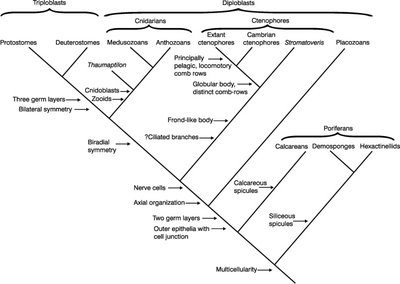
Phosphatized Pre-Cambrian Embryos of China
China is justifiably reknowned for remarkably preserved Cambrian fossils from the Chengjiang Lagerstätte that have been discussed here previously. Perhaps of equal significance are microscopic fossils recovered from the earlier pre-Cambrian Doushantuo Lagerstätte in Guizhou province to the northwest.
The Doushantuo Formation is dated between 590-565 mya. This is a period after the worldwide glaciation of "Snowball Earth" fame and before the onset of the Cambrian. It is known biochronologically as the Ediacaran and is characterized by enigmatic fossils that show only tentative links to later Cambrian phyla. Other Ediacaran fossils are idiosyncratic and perhaps did not survive in later biotas.
This post will summarize recent research on microscopic embryos from the Doushantuo Formation that preserve remarkable morphologic detail, both externally and internally. PZ Myers at Pharyngula has a number of posts regarding this material and I will defer to his expertise in discussing these finds. His first post simply introduces these microfossils and the fact that they actually are what they are said be be, unbelievably well-preserved microscopic fossil embryos from 570 mya! Research up to that point was merely able to describe the external structure of the embryos, including their stage of division, and other phenetic differences between them, suggesting that they represented a variety of life forms. What the adult organisms were like is still in large measure unknown, although some were, and still are, thought to be early bilaterian animals. This link gives a synopsis of the diversity of animaforms tentatively identified with the Doushantou phospherites.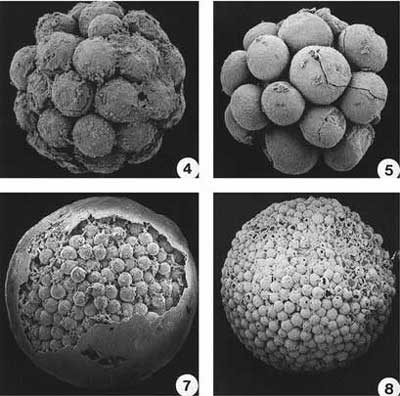
The second post at Pharyngula discusses recent work that helps elucidate exactly under what circumstances embryos of these sorts can be preserved. The research also explains why there seems to be differential survival of these organisms at certain prefered stages of development. The third post discusses the developmental biology of these early embryos and how it reflects a type of asymmetry seen in relatively sophisticated metazoan animals.
The final post is of greatest significance as it reports on recently published descriptions of the internal structure of similarly preserved embryos from the Lower Cambrian Kuanchuanpu Formation, in Shaanxi Province, China. The researchers used an advanced imaging technique called synchrotron-radiation X-ray tomographic microscopy (SRXTM) that allows for the unprecedented non-invasive analysis of the previously indeterminate submicrometre internal structure of phosphatized embryos.
... together with evidence from comparative taphonomy, the case is now very strong for rejecting claims of anthozoan planula larvae, hydrozoan and bilaterian gastrulae, as well as minute adult bilaterians from the Ediacaran Doushantuo phosphorites.This is an important statement as it was thought by many that certain specimens from Doushantuo assigned to a new genus and species Vernanimalcula guizhouena, were in fact the earliest bilaterian in the fossil record. The results of this latest study apparently place these earlier claims in doubt.
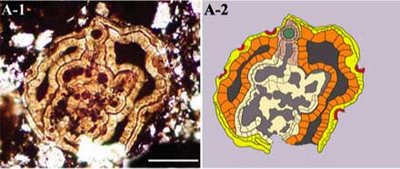 Vernanimalcula guizhouena , purported to be the earliest bilaterian fossil may need to be re-evaluated based on research results using synchrotron-radiation X-ray tomographic microscopy (SRXTM)
Vernanimalcula guizhouena , purported to be the earliest bilaterian fossil may need to be re-evaluated based on research results using synchrotron-radiation X-ray tomographic microscopy (SRXTM)Update on Chinese Paleontology
As I continue to document the fossil record of China on the web with original contributions and links to other blogs, I will periodically publish indices of posts pertaining to particular aspects of Chinese paleontology arranged in chronological order. This will ultimately serve as a scafolding for a comprehensive overview of Chinese natural history.
Chronological index of posts dealing the non-primate fossil record of China:
- Early Cambrian Echinoderms of China
- Early Chinese Fish-like Vertebrates and Pre-vertebrates
- The Chinese Evidence for the Evolutionary Origin of Fish
- Origins of Lobe-finned Fish
- Panda's on the Mend
Tuesday, August 08, 2006
A Species Odyssey: A New Form of Scientific Creationism
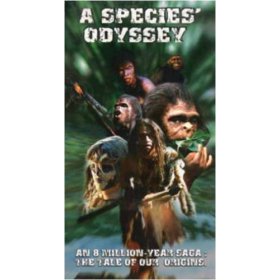 Happened to see a two part series on the Science Channel recently called "A Species Odyssey." It attempts to portray the course of human evolution from the earliest purported "hominids" such as "Toumai" and "Orrorin" through to the demise of the Neanderthals and the emergence of modern humans. It is done in a dramatic, narrative style using state of the art animatronics to depict proto-human ancestors and various extinct mammals, and actors with fanciful make-up to simulate how more human-like ancestors may have appeared.
Happened to see a two part series on the Science Channel recently called "A Species Odyssey." It attempts to portray the course of human evolution from the earliest purported "hominids" such as "Toumai" and "Orrorin" through to the demise of the Neanderthals and the emergence of modern humans. It is done in a dramatic, narrative style using state of the art animatronics to depict proto-human ancestors and various extinct mammals, and actors with fanciful make-up to simulate how more human-like ancestors may have appeared.
Although the series tries to present the saga of human evolution from a science-based perspective, the science behind it is, unfortunately, all wrong. I was astonished by the license the producers took with the known fossil record.
The opening scenes focus on a troop of proto-hominids, called alternatively either monkeys or apes, who are faced with an increasingly desiccated east African environment, leading to the retreat of their forested refugia and the spread of more foreboding savannah grasslands. In response, individual apes meet the challenge by standing upright and taking the first bipedal steps. This is presented in an episodic fashion leaving the impression that evolution proceeds by quantum leaps and willful intent. In point of fact, the so-called "savannah hypothesis" of bipedalism has been abandoned by nearly all researchers over the last twenty years. It is now widely accepted that bipedalism emerged in the forests not out on the savannah. The shift to an open grasslands adaptation occurred millions of years later with the advent of the genus Homo.
In this same sequence the first "hominid" is depicted as some sort of "hopeful monster," born to a pair of retrograde apes, sort of like the baby Jesus born to redeem a bestial past. This sequence sets the almost Biblical tone of the next two hours and is as false a notion as any creationist screed concerning human origins that I've ever encountered. In these videos natural selection and evolutionary adaptations just simply happen sui generis. Confront an ill-adapted vulnerable hominid with an environmental challenge, give it the will to survive and presto the new physical or behavioral trait appears, deus ex machina, almost instantaneously. This series and many other popular accounts of human evolution and evolution in general seem to have an inherent tendency to see evolution in volitional and teleological terms. The bad science that this projects and the naive and corrupted version of evolution thus presented become grist for the mill of ID creationists who can use these mischaracterizations of evolutionary theory to validate their own preconceptions and misrepresentations of what evolutionary biology is all about.
This really becomes an unintended form of scientific creationism cast in a secular mold. There is a mythic, almost otherworldly aura surrounding the emergence of various human adaptations throughout the videos. These are none other than scriptural-like recountings of key human innovations, more or less akin to culture hero creation stories found in nearly all human societies. It may make for good or bad theater but not science, and to my mind does a grave disservice to developing a true understanding of the evolutionary process.
In addition to this fundamental misconception of how evolution actually takes place, the series is replete with plain and simple factual errors. One glaring mistake is to unequivocally state that two species of australopithecine, Austalopithecus afarensis and Australopithecus anamensis co-existed and were competitors. This is simply not true, "anamensis" preceded "afarensis" in the fossil record and most anthropologists see it as the latter's direct ancestor. The purported behavioral differences between these two species shown in the video are without any foundation and totally made up out of whole cloth.
I could go on and on about all the factual errors and mistakes made in this production. Not only do they give a distorted picture of human evolution, but they also play into the hands of critics of human evolutionary research as they perpetuate false claims and notions that become straw men for creationists to attack.
One major theme throughout the series is the idea that there were primal conflicts between different species of prehuman. These species however are portrayed more or less as rival gangs along the lines of Canaanites versus Isrealites. There is no understanding of the biological species concept and the various species of hominid are shown interbreeding at will.
The reverential and naive narrative comes across as almost religious in tone, as if the producers were consciously trying to create a new secular version of Genesis. Moreover, the depiction of human ancestors also leaves me cold. Although some of the graphics are well done, the way early humans are shown moving about their environs is very stilted and unrealistic.
In sum, much of this series is totally fabricated and only vaguely reflective of what we really know about human evolution. In my opinion it does much more harm than good. A dramatic series of this sort could be done in a truly scientific manner that is consistent with what we really know, rather than in the bowdlerized fashion given here.
Sunday, August 06, 2006
More on Euarchontans
A recent post here at Sinanthropus discusses the relationship of primates to other mammals within a supraordinal clade called Euarchontaglires and their possible Asian origins. Euarchontaglires consists of two closely related groups: Euarchonta, including the mammalian orders Primates, Dermoptera (flying lemurs or colugos) and Scandentia (tree shrews), and Glires, including Rodentia and Lagomorpha (rabbits, hares and pikas). Until recently bats (Chiroptera) were usually included with the primates, flying lemurs and tree shrews in a group called Archonta. With the realization that bats are not closely related to other archontans the core archontans have been reformulated as euarchontans (i.e. true archontans).
Darren Naish over at Tetrapod Zoology has a post on the controversy surrounding the suggestion that "flying foxes" or fruit bats are distinct from other bats (microchiropterans) and are actually close relatives of primates and other euarchontans. These megachiropterans or megabats are an interesting group that for a brief period in the late 1980s were thought by some to be so-called "flying primates." As Darren shows this view is no longer favored. Megabats are widely distributed throughout the equatorial latitudes of Southeast Asia, Australasia and Africa, as one would expect given their volent adaptation. While not apparently closely related to euarchontans it is interesting that megabats share the same biogeographic zone as the "flying lemur" and the tree shrew, along with the prosimian tarsier in insular southeast Asia, as well as a suite of neurological features with primates, a neat example of evolutionary convergence if there ever was one.
Saturday, August 05, 2006
Rethinking the Role of Pliopithecids in Hominoid Evolution
The pliopithecids are some of the most enigmatic fossil primates, long thought to be gibbon ancestors. They boast, however, a series of primitive dental, cranial and post-cranial features that have led many to doubt their earlier assumed hominoid affinities and ancestral gibbon status. Some go so far as to suggest that they predate the emergence of the catarrhine crown group and are a continuation of an ancestral anthropoid clade that evolved convergently with modern catarrhines.
On the other hand, relatively complete cranial remains attributed to pliopithecids in both Europe (Epipliopithecus vindobonensis) and China (Laccopithecus robustus) bear an uncanny resemblance to modern gibbons. Can it be that pliopithecids have been given a bad rap? I will argue in this post that regardless of their primitive morphological features the place of pliopithecids in hominoid phylogeny should be reconsidered based primarily on biogeographic and biochronologic grounds.
For instance, molecular studies indicate that the last common ancestor (LCA) of living hominoids, including the lesser and greater apes may have existed as recently as 15 mya. This date is consistent with a 6 million year old molecular age for the chimpanzee/human LCA and a 12 million year old molecular age for the LCA of the Asian orangutan and the African apes and humans. These dates are in accord with the fossil record which has protohominid ancestors of the australopitecines such as Sahelanthropus and Orrorin appearing 6-7 mya, orangutan-like Asian apes such as Sivapithecus emerging ~ 12 mya, and gorilla-like European ancestors of African apes such as Ouranopithecus appearing slightly later (see my previous posts on homind origins here and here). It can, therefore, be legitimately argued that ancestral gibbons should occur in the fossil record around 15 mya.
As argued previously there is what might be called a phylogenetic node of approximately 1 to 2 million years duration that can be hypothesized to surround any given primate LCA. That is to say, it should be virtually impossible to distinguish the immediate predecessor and the immediate successors of an LCA from the LCA itself, particularly when dealing with a fragmentary fossil record dominated by extremely liable dental remains. Factor into this picture the potential for homoplasy amongst primates (i.e the frequency of parallelisms and convergences between primate lineages) and we get an extremely complex evolutionary matrix.
It can be argued, for instance, that the last common ancestor of the living hominoids may have retained a suite of primitive features lost in parallel by its living descendants. It can also be argued that many traits thought to be shared derived features of living hominoid taxa, such as a suspensory locomotor adaptation, likewise evolved in parallel. As regards extant hylobatids (i.e. the living gibbons and siamangs) it can be further argued that some of their uniquely derived features, such as their adaptation for extreme brachiation abilities and lack of body-size and canine-size sexual dimorphism evolved relatively recently and should not characterize stem hylobatids (that is hylobatid ancestors occurring prior to the LCA of living gibbons and siamangs which arguably lived relatively recently within the last 3-4 million years).
With all these caveats in mind how then can the hominoid LCA be recognized in the fossil record? First off, it should have all the primitive features retained by the living hylobatids vis-à-vis the great apes and humans, such as a fenestrated palate. Secondly, its retention of other primitive features, lost in all living hominoids, should not preclude it from being the LCA or close to it. Thirdly, the appearance of features seen in some hominoids but lost or transformed in hylobatids should also be expected (i.e. ancestral gibbons may not have been suspensory brachiators and they were most assuredly highly sexually dimorphic). Finally, and perhaps most importantly, recognition of secular temporal trends leading from a primitive ancestor to more and more derived descendants showing an increasing accretion of gibbon-like features through time, can serve to link highly derived extant hylobatids with primitive ancestors in the fossil record.
Let’s illustrate a possible interpretation of pliopithecids as hominoid cum hylobatid ancestors in light of the above considerations. Firstly, most researchers discount pliopithecids as hominoid ancestors because they possess a suite of pre-catarrhine-like features seen in both prosimian and platyrrhine primates, but lacking in living and extinct old world monkeys and apes. Pliopithecids are also distinguished by possession of uniquely derived features not seen in other anthropoids, in particular the so-call pliopithecine triangle on the occlusal surface of their lower molars. Finally, those features that they share with modern gibbons are said to be either primitive retentions or homoplasies of little or no phylogenetic significance. These are all powerful arguments against the hominoid affinities of pliopithecids.
But let’s look at these data through the prism of secular evolutionary trends amongst pliopithecids and hylobatids. The earliest and most primitive pliopithecids are now known from Asia. In particular, the primate fossil taxa Dionysopithecus and Platodontopithecus from the early Miocene site of Sihong in Jiangsu, China discussed in my last post, are now widely regarded as the base of the pliopithecid adaptive radiation. Slightly later, the classic pliopithecids of Europe make their first appearance. The apparent Asian origin of pliopithecids is in keeping with the previously discussed possibility that the primates themselves had Asian origins and the evidence for the Asian origins of the anthropoids per se, to be discussed in a future post.
This is where biogeographic and biochronologic considerations come into play. Both gibbons and orangutans are found exclusively in Asia. Molecular data place the LCA of living hominoids between 15-17 mya. It seems logical then that the hominoid LCA should be found in Asia between 15-17 mya and, lo and behold, there are candidates in the guise of Dionysopithecus and Platodontopithecus. But isn’t it a stretch to argue that these scrappy specimens are close to the hominoid LCA when Africa is replete with abundant protocatarrhines and protohominoids from the earliest Miocene, preceding the Sihong material by millions of years? According to the argument presented here, the African finds may merely be fortuitous and could represent either an ultimate source for the Asian LCA of the hominoids or collateral protocatarrhines that dispersed earlier from Asia to Africa and eventually went extinct without issue.
Let’s follow this line of argumentation a bit further. It is now generally agreed upon that the early pliopithecids, with a wealth of primitive features, are followed by more derived pliopithecids from the middle and late Miocene, placed in a subfamily called the Crouzeliinae. Most of the features distinguishing crouzeliines from pliopithecines (the earlier subfamily of pliopithecids) relate to minute dental features and will not be discussed herein. Crouzeliines, however, tend to shown a decrease in some typical pliopithecid features such as degree of expression of the pliopithecine triangle and an increase in post-cranial features relating to a suspensory locomotor adaptation, such as increased curvature of the phalanges.
The most recent member of the Crouzeliinae is Laccopithecus robustus from the late Miocene (~ 7 mya) Chinese site of Lufeng in the southern province of Yunnan.
Laccopithecus is one of the best represented plioipithecids. As David Begun, an authority on European pliopithecids states:
Laccopithecus robustus is known from a rich sample of about 90 specimens, including a partial cranium with a well-preserved face and palate, as well as a number of more fragmentary jaws, associated dentitions, isolated teeth and a proximal phalanx (Pan, 1998) ... Laccopithecus robustus is a medium-sized primitive catarrhine ... Females are close in molar size to siamangs, whereas males are somewhat larger ... There are no pliopithecine triangles on any of the lower molars and the buccal cingula are minimally developed ... Two damaged mandibular symphyses suggest that the anterior part of the mandible was robust with well-developed transverse tori while the posterior portion appears to have been relatively gracile in transverse dimensions ... The male upper canine is very large and strongly bilaterally compressed. All three upper anterior teeth in fact closely resemble their homologues in hylobatids, though this is not the case for the lower incisors, which are lower-crowned and broader in hylobatids. Another important distinction from hylobatids is the presence of sexual dimorphism in canine morphology, as in nearly all other anthropoids ... The cranium of L. robustus is badly damaged, as is the case for most specimens from Lufeng. The palate is narrow anteriorly, as in Epipliopithecus and it appears to have been fenestrated. As in Epipliopithecus, Anapithecus and Hylobates, the nasal aperture is tall but small and narrow overall, with a narrow base and an apex that reaches above the lower level of the orbits ... Finally, the single proximal phalanx of Laccopithecus is long and curved, with strong muscle markings suggestive of suspensory positional behavior (Meldrum & Pan, 1988).
The above is an abridged description highlighting certain secular trends relating features characteristic of primitive pliopithecids to features reminiscent of later hylobatids. What we see is the retention of primitive features (fenestrated palate) only seen in hylobatids amongst living hominoids, the loss of a derived feature associated with earlier pliopithecids (the pliopithecine triangle), the presence of a primitive character (canine and size sexual dimorphism) retained in the great apes but lost in extant hylobatids, and the enhancement of adaptations for suspensory movement in the trees.
Although still rather sketchy, an argument can be framed that the pliopithecids are the Asian root of the hominoid radiation and their Asian members represent a processional lineage leading from a Dionysopithecus/Platodontopithecus-like ancestor through the more advanced crouzeliine Laccopithecus to the modern gibbons and siamang of southeast Asia. Laccopithecus, which is in the right place and at the right time, thus becomes a crucial link between the pliopithecids and later hylobatids.
Of Rock Rats and Drunken Apes
The Laotian Rock Rat (Laonastes aenigmamus) was first described scientifically in April 2005 and identified as a member of an entirely new family of mammals.
It gained international attention again on March 10, 2006 when scientists published a paper in Science magazine re-identifying the animal as a member of the Diatomyidae, a family of rodents that had been previously thought extinct. Laonastes is thus a “relic species” or "living fossil" whose last known relatives lived 11 million years ago.
As Mary Dawson and Chris Beard, paleontologists at the Carnegie Museum of Natural History, stated:
According to Wikipedia:Diatomyids are rodents that lived during the middle Tertiary (34 - 11 million years ago) in southern Asia, central China, and Japan. They were rodents of medium size and highly characteristic molar teeth and jaw structure. Three known fossil genera- Fallomus, Diatomys, and Willmus- are recognized in the Diatomyidae. Some fossils are known from isolated teeth and jaw fragments. Others such as Diatomys are better known and more widely distributed.
The family has a nearly continuous fossil range from Early Oligocene fossils of Fallomus from the Lower Chitarwata Formation (32.5 Ma; Bugti Member, Bugti Hills; Flynn et al., 1986) in Balochistan, Pakistan to Middle/Late Miocene fossils (11 Ma) of Diatomys in east and southeast Asia.Laonastes is in fact so similar to Diatomys that details of the morphology of the former were predicted by reference to the latter. Accordingly, when Chinese paleontologist Li Chuankui, who originally described the genus, recently discovered a new species of Diatomys it showed a remarkable degree of similarity in its skull, tooth and jaw structures to the living Laonastes.
Given the fact that Laonastes and Diatomys are so similar in morphology, a study of the living environment of the Laotian Rock Rat may help us better understand the paleoevironment of other diatomyids. In addition, by better understanding their paleoenvironment, the biogeographic distribution of diatomyids in the fossil record can help us better understand the dispersal patterns of other associated sympatric species.
The type species of the Diatomyidae, Diatomys shantungensis, was first described in 1974 by Prof Li Chuankui from the well known early Miocene site of Shanwang in Shandong province, China. Shanwang is of special interest because of the prolific nature of its fauna and flora and the unprecedented state of preservation of its fossils, found in a very fine-grained diatomitic lacustrine depositional environment. The site has thus become the type site for the Chinese early Miocene. As we shall see, this is of particular interest to students of primate evolution.
 Remarkable state of preservation of Diatomys shantungensis from diatomitic deposits at Shandong, China
Remarkable state of preservation of Diatomys shantungensis from diatomitic deposits at Shandong, ChinaSihong, in Jiangsu province, is another important fossil bearing site. First found in the 1950s it was initially thought to contain an early Pleistocene fauna. Reevaluation of the original specimens and additional discoveries led to recognition that the site was contemporary with Shanwang and represented a similar paleoecology. In this regard it is interesting to note that Diatomys shantungensis is known from both sites.
Though relatively unheralded, Sihong is an extremely important site from a paleoprimatological perspective. Geochronologically both Shanwang and Sihong are now recognized to be of early Miocene provenience, ~ 17 mya. Given the abundance of fossil mammals recovered at Shanwang it was always a dream of Chinese paleontologists that fossil primates, in particular fossl hominoids, might eventually be found there. Alas, to this date no primate material has been forthcoming from Shanwang. The more southerly, contemporaneous Sihong site has, however, more than fulfilled the hopes of not only Chinese paleontologists, but paleontologists worldwide, with the recovery of a significant primate fauna, including what are arguably early protohominoids similar to the proconsuline protoapes of East Africa and/or the proto-gibbon-like pliopithecids of Miocene Europe.
 Lower molars of Platodontopithecus from the early Miocene site of Sihong, Jiangsu, China (from Harrison and Gu, 1999)
Lower molars of Platodontopithecus from the early Miocene site of Sihong, Jiangsu, China (from Harrison and Gu, 1999)The placement of protoapes in East Asia at the same time they appear in East Africa is a challenge to commonly held beliefs about the exclusivity of Africa as the homeland for the catarrhine and hominoid adaptive radiations and speaks to the fact that the biogeographic distribution of primate groups in the late Paleogene and early Neogene is much more complicated than previously thought.
It is in this manner that the discovery of the Laotian Rock Rat gains added significance. As a relic of the early Miocene Shangwangian biochronologic age, Laonestes opens up a window on this long gone epoch, when early ape-like creatures may have spread throughout south, east and southeast Asia. What relationship these early protoapes (represented until now mostly by isolated teeth and some scrappy jaw fragments) have to the later appearance of true modern apes in the same region during the Middle and Late Miocene (7-12 mya) is a topic that has garnered little attention. Only with the recovery of more diagnostic elements of the cranial and post-cranial skeletons of these early apes will their relationships to other primates become better understood.
Shangwangian-like faunas are, however, found spread throughout south, east and southeast Asia during the early Miocene, so we can tentatively assume that the protoapes of Sihong had a similar distribution (for that matter, one primate taxon from Sihong, Dionysopithecus, named after the Greek god of wine, has been found in Pakistan).
The Diatomyidae, the family to which the Laotian Rock Rat has been assigned is described by Qiu and Li as follows:
DIATOMYIDAE: Diatomys shantungensis, collected from Shanwang and Sihong, is the only Chinese species of this family. Diatomys was first considered indeterminate to family and questionably referred to Geomyoidea (Li, 1974). Some students transferred it to the family Pedetidae (McKenna and Bell, 1997). We follow P. Mein and L. Ginsburg (1997) in their definition of a new family for this genus plus probably Fallomus. Diatomys is also known from Thailand, Pakistan, and Japan (Kato and Otsuka, 1995), and appears to be a kind of wet/warm-adapted animal distributed in a tropical or subtropical area.This suggests that the environment in which modern Laonestes is found is a biological refugia and good analog to what the environments of Shanwang and Sihong may have been like 17 million years ago when protoapes roamed the forests of East Asia.
Tuesday, August 01, 2006
Recent Discoveries of Interest
One reason for "Sinanthropus" is to serve as a clearing house for info on Chinese paleontology. With that goal in mind I am using this post to highlight three recent discoveries regarding quite different aspects of the Chinese fossil record. These include the recent description of Mesomyzon mengae, a new early Cretaceous lamprey; the discovery and analysis of Gansus, the earliest known amphibious bird; and the capture of the Laotian Rock Rat (Laonastes aenigmamus). Before discussing these finds in future posts, I'd like to direct a word of thanks to Michael J. Ryan for the above links to his Palaeoblog. My next post will discuss the discovery of the Laotian Rock Rat and how it relates to hominoid evolution in Asia during the early and middle Miocene.



